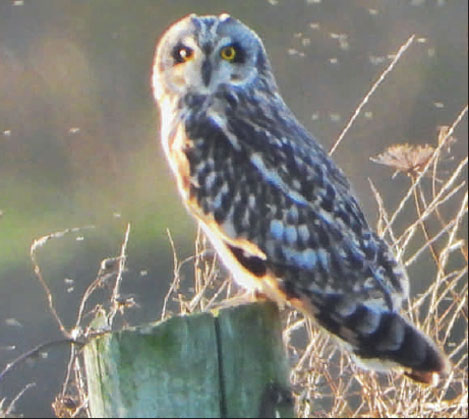|
I’d hoped to write about seeing a Short-eared
Owl. One of the birds had been seen regularly on a headland
just north of Balbriggan. They are regular winter visitors to
Ireland and north county Dublin is a good spot to find them
where they favour tillage fields near the coast. They breed
in the far north of Europe, the closest breeding pairs are probably
in the northern isles of Scotland with most of the species close
to the Arctic circle where they will be breeding during days
of almost continuous sunlight so they are daytime hunters, unlike
our Barn and Longeared
owls which are strictly nocturnal hunters.
A friend, Gustavo, had got a wonderful
photo of one sitting in a stubble field in Balbriggan and had
given us a good map of where the birds had been seen so we set
off with high hopes and expectations on a day that was cold
with brisk northerly winds but dry with dazzling sunshine. I’d
never walked along that stretch of coastline before and it was
very impressive with the tide way out and lots of bird life
along the shore. Looking north over the sea you could see snow
covered mountains in the Mournes. Curlews flew over in little
flocks to feed in the farmland just above the shore while Ringed
Plover, Turnstones, Redshanks and Dunlin
busied themselves along the waters edge.
We got to the headland and made our
way up from the beach and followed the path, circling the field
to the area on the map which was a mound of earth with brambles
growing around the base. We approached tentatively but no large
eyes stared at us from a tussock or no bird took to the air
with broad wings flapping silently. We scanned the surrounding
fields from the top of the mound then walked along the length
of the nearest hedgerow. A big flock of Brent geese flew over
a distant field and a little flock of Linnets busied themselves
feeding on grass seeds among the dried up maize stems. But no
owls! I’ve seen them a few times before, on the site of
the old Baldoyle race course, then a big field now a housing
|
|

Short-eared Owl
on post in Balbriggan Photo: Gustavo
Zoladz
|
estate,
where we saw two of the owls quartering low over
the ground looking for rodents then landing and staring back at
us from the grass while a Buzzard perched on a
tree in the background. I’d spent a happy hour or two in
a lane in Donabate watching two Short-eared Owls buzzing each
other in an adjoining field. They sometimes appear further south,
we’ve seen two a couple of times one near Booterstown marsh,
one flying over the undeveloped land north of the marsh and another
morning before we began a wader count on the beach one flew out
from where it was roosting in a tree beside the Dart car park.
When he used to live in Dalkey renowned birder Dick Coombes would
regularly see them wintering on Dalkey Island, perfect hunting
ground for them with its then abundance of rabbits and rats.
We wandered around the Balbriggan field and
were greeted by a pair of walkers asking us had we seen the owl?
They had seen it regularly so we knew we were in the right place
even if the owl wasn’t. Maybe the numbers of Saturday walkers
had driven it or them to another field. Subsequently the owl was
seen again at the same spot so when a friend said he was going
out to have a look we gladly accompanied him. It was an even more
beautiful morning than our last visit. The sea was flat calm and
through the telescopes we watched rafts of Common Scoters, a scarce
breeding duck in Ireland but in winter they are joined off the
coast by birds from the Continent. Apparently they usually feed
for molluscs in water less than 12 meters deep and it was the
low tide that brought them in so close. Hundreds, possibly thousands
of them dived, flew across the sea in little groups or sat on
the mirror like water. You can see them in Dublin Bay but I’d
never seen such numbers as was before us here.
We walked up the shore again and reached
the field. Once again a local on a stroll appeared, told us there
had been three or four owls which he’d see regularly but
he hadn’t seen them for a week or more. We walked the periphery
of the fields, a large flock of Chaffinches flew up into the Hedgerow
ahead of us while a Song Thrush sang from the hedge beside us.
But no owl! We set off back towards the car park. The tide was
coming in and little flocks of Dunlin and Turnstone fed on the
waters edge just a few yards away. Waders were gathering on rocks
as the sea lapped around them and on one cluster of rocks were
a number of Golden Plover |